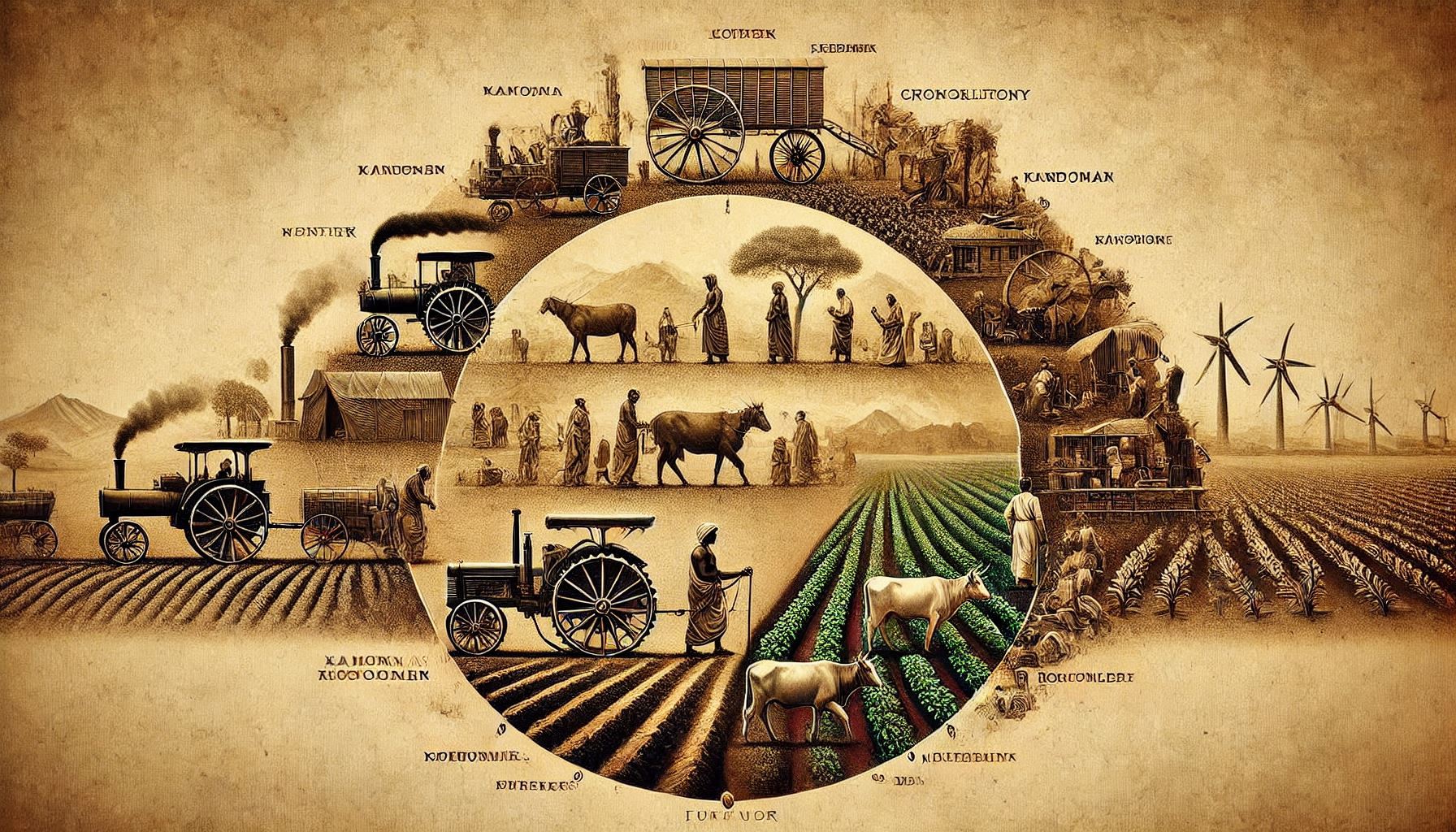Weather forecasting One Liner
- Climatic normals represent the average value of a weather element over 30 years.
- Climatic normals help determine the best crop distribution, production, and productivity.
- Crop production can be maximized by selecting crops suited to the climatic normals of an area.
- Weather forecasts predict weather for the upcoming days, helping plan activities.
- Weather forecasts are crucial for managing the social and economic impacts of weather conditions.
- Weather aberrations can explain up to 50% of variations in crop production.
- Rainfall forecasts are the most important for deciding crop production and national economic planning.
- Effective weather forecasting helps in moisture conservation during weak monsoons and flood relief during strong monsoons.
- Reliable weather forecasting reduces damage caused by unfavorable weather.
- Forecasting pest and disease outbreaks based on weather conditions can minimize crop losses.
- Weather forecasts assist in maintaining food grain prices through buffer stock operations.
- Judicious use of water in regions can be planned based on accurate weather forecasts.
- Weather forecasting can be categorized into short-range, medium-range, and long-range forecasts.
- Short-range forecasts typically last up to 72 hours, predicting immediate weather phenomena like rainfall and storms.
- Very short-range forecasts predict weather up to 12 hours in advance, offering crucial updates for immediate needs.
- Medium-range forecasts cover periods beyond 3 days but up to 10 days, useful for farmers to anticipate rainfall and temperature.
- Long-range forecasts predict weather beyond 10 days, up to a season, useful for planning agricultural cycles and monsoon expectations.
- Synoptic charts are used to analyze vast meteorological data for weather prediction.
- Synoptic charts display weather conditions at specific times over a large area using standard weather codes.
- Surface synoptic charts are the most widely used, providing pressure, temperature, wind, and precipitation data.
- Upper air charts are prepared at standard pressure levels to show atmospheric conditions at different heights.
- Surface and upper air charts together offer a three-dimensional view of weather at a given time.
- Isobars are narrow black lines on synoptic charts representing areas of equal pressure.
- Pressure values in hPa are indicated at the ends of isobars on synoptic charts.
- Shading on synoptic charts indicates precipitation.
- Arrows on synoptic charts show wind direction, and feathers on arrows represent wind velocity.
- Small circles with shading represent cloud cover on synoptic charts.
- Weather phenomena on synoptic charts are marked using distinct symbols for clarity.
- A weather calendar helps farmers understand weather patterns and make decisions about crop management.
- A weather calendar includes detailed information about crops and the weather conditions they require.
- The bottom part of the weather calendar shows crop activities and phenological stages.
- The middle part of the weather calendar provides information on the normal weather conditions for active crop growth.
- The middle part of the weather calendar includes data on rainfall, temperature, pan evaporation, and sunshine hours.
- The top part of the weather calendar alerts farmers to abnormal weather conditions and precautionary measures.
- The top part of the weather calendar includes sections on dry spells, high winds, heavy rainfall, and cloudy weather.
- Crop weather calendars are designed to help farmers interpret weather information to safeguard crops.
- Meteorological data is collected continuously from around the world through telecommunication channels.
- Operational meteorologists use synoptic charts to assess and forecast weather conditions.
- Accurate weather forecasting is essential for disaster risk reduction, especially in agriculture-dependent areas.
- Satellite technology is crucial in monitoring and forecasting weather conditions globally.
- The accuracy of weather forecasts depends on data from various sources, including satellites, ground stations, and weather balloons.
- Weather forecasting involves interpreting complex atmospheric data to predict short-term and long-term weather conditions.
- Weather forecasting plays a key role in managing water resources in drought-prone and flood-prone areas.
- Seasonal forecasts help farmers decide which crops to plant based on expected rainfall and temperature patterns.
- Early warning systems for severe weather events help reduce the impact on communities and infrastructure.
- The quality of weather forecasting has improved with advancements in computing technology and data assimilation techniques.
- Modern weather models use simulations to predict the atmosphere’s behavior, improving forecast accuracy.
- Long-range forecasting helps policymakers and planners prepare for seasonal shifts and extreme weather events.
- Local weather forecasts provide timely updates that help communities and businesses adapt to daily weather changes.
- Climate models predict long-term trends in weather patterns, aiding in climate adaptation strategies.
- Weather data is critical for aviation, marine, and agriculture sectors to operate safely and efficiently.
- Farmers can plan irrigation schedules more effectively with the help of weather forecasts.
- Weather forecasting helps in managing risks associated with agricultural production and food security.
- Understanding seasonal variations in temperature and rainfall helps farmers optimize planting schedules.
- Meteorological data, including temperature, humidity, and wind speed, are essential for accurate weather forecasting.
- Accurate forecasting is crucial for planning large-scale events, such as festivals, sports events, and outdoor activities.
- Public weather warnings help protect life and property by advising people about impending severe weather.
- Climate variability affects the timing and intensity of weather events, making forecasting challenging but necessary.
- Advances in weather radar technology help track precipitation patterns and provide early warnings for storms.
- Weather models incorporate various atmospheric parameters, including pressure, temperature, and moisture levels.
- Real-time weather observations are essential for making accurate and timely weather forecasts.
- Weather forecast models are continuously updated as new data is collected, improving forecast reliability.
- Short-term weather forecasts focus on immediate and localized weather events, such as thunderstorms or heatwaves.
- Medium-range forecasts help anticipate broader weather patterns, such as droughts or prolonged rainy spells.
- Long-range weather forecasting is often based on statistical models and historical weather patterns.
- Weather predictions are often given as probabilities, acknowledging the inherent uncertainty of forecasting.
- Forecasting technologies rely on sophisticated algorithms to analyze vast amounts of meteorological data.
- Seasonal forecasts are especially important in countries with monsoon-driven agricultural economies.
- Predicting extreme weather events, such as hurricanes or tornadoes, is a key focus of modern weather forecasting.
- Accurate weather forecasts are critical for transportation, as weather conditions can affect road, rail, and air travel.
- Weather prediction is essential for disaster preparedness, reducing casualties and economic losses.
- Regional weather forecasts help local governments prepare for emergencies like floods, wildfires, or snowstorms.
- High-tech weather stations monitor environmental variables like temperature, pressure, humidity, and wind speed.
- Weather forecasting for marine activities ensures the safety of ships and offshore operations.
- Early detection of weather anomalies can help authorities mitigate damage from floods, storms, and heatwaves.
- Weather data helps in assessing air quality and its potential impact on human health.
- Crop weather forecasts allow farmers to protect crops from pests, diseases, and adverse weather.
- Daily weather forecasts are often broadcast on radio, TV, and online platforms, making them accessible to the public.
- Advanced weather models use machine learning and artificial intelligence to improve forecasting accuracy.
- Local weather stations collect data on wind, temperature, and rainfall to create accurate short-term forecasts.
- Climate change has made long-term weather forecasting more complex, requiring updated models and new data.
- Forecasting innovations include the use of drones and unmanned aerial vehicles (UAVs) to collect weather data.
- Weather stations across the globe provide a network of data for more accurate and comprehensive forecasts.
- Meteorologists use supercomputers to process vast amounts of weather data and run predictive models.
- The accuracy of weather forecasts has steadily improved, reducing errors in predictions over the last few decades.
- Meteorological satellites provide real-time data on cloud cover, temperature, and atmospheric composition.
- Weather forecasting models rely on historical weather data to detect patterns and predict future conditions.
- The integration of big data in weather forecasting is revolutionizing how meteorologists predict weather.
- Effective communication of weather forecasts is critical for public safety, especially during extreme weather events.
- Weather models take into account various atmospheric layers, providing detailed insights into weather phenomena.
- Accurate weather forecasting supports sustainable agriculture by helping farmers adapt to changing weather patterns.
- Collaboration between national meteorological agencies enhances the quality and accuracy of weather forecasts.
- Continuous monitoring of atmospheric conditions is essential for forecasting sudden changes in weather.
- Weather patterns and data are critical for assessing the potential impact of climate change on regional ecosystems.
- Understanding local topography and microclimates is key for improving weather forecast accuracy in specific regions.
- Advanced weather prediction tools have transformed disaster response, allowing faster and more effective interventions.
- Rapidly changing weather conditions require adaptive forecasting models to meet the needs of various sectors.
- Weather forecasting for natural resource management helps ensure sustainable practices in agriculture, forestry, and fisheries.
- Weather data analysis plays a vital role in predicting the spread of wildfires and other natural disasters.
- Continuous research in meteorology is essential for improving weather forecasts and enhancing climate resilience.










